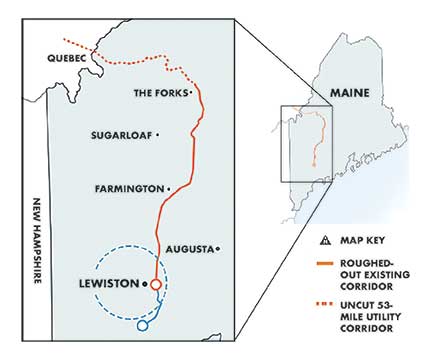AP – Maine’s highest court on Tuesday upheld the lease for a small section of state land for a $1 billion electric transmission corridor, a victory for developers who hope to complete the project.
(Note: this is the project that was launched after New Hampshire scuttled the Northern Pass line)
The Supreme Judicial Court ruled unanimously that the Maine Bureau of Parks and Lands acted within its authority in leasing a 1-mile (1.6-kilometer) stretch of the 145-mile (233-kilometer) power transmission line. All told, the state lease covered about 32 acres (13 hectares) of land in western Maine.
The New England Clean Energy Connect remains on hold pending the outcome of another legal case focusing on the constitutionality of a referendum in which Maine voters rebuked the project.
Central Maine Power’s parent company, Avangrid, and Canada’s Hydro Quebec teamed up on the project that would supply up to 1,200 megawatts of Canadian hydropower to the New England power grid.
Supporters say such bold projects are needed to address climate change. Critics contend the power line would destroy woodlands while failing to deliver on promised environmental benefits.
Opponents decried the court’s conclusion that the lease didn’t represent a substantial alteration or reduction of land warranting a vote of state lawmakers, as required under a 1993 amendment to the Maine Constitution.
Most of transmission line would be built along existing utility corridors, but a new 53-mile (85-kilometer) section was needed to reach the Canadian border.
Workers had been clearing trees and setting poles for months when the governor asked for work to be suspended after the referendum last year. The referendum on the project was the costliest in Maine history, topping $90 million and underscoring deep divisions.
The project would be funded by Massachusetts ratepayers, but supporters say the introduction of so much electricity to the grid would stabilize or reduce electricity rates for all consumers. The project would supply enough electricity for about 1 million homes.


 Return to the Concord Monitor
Return to the Concord Monitor
NH missed out on this clean energy opportunity.
Kudo’s to the people of the state of Maine. Thanks to their forward-thinking people, they have natural gas pipelines, passenger rail, a gasoline/crude oil pipeline (depends on which way it is pumping which product it carries), and soon a connection to the largest waterpower source in North America. I only hope that they are insisting on a converter station in Maine.
Shame on NH!